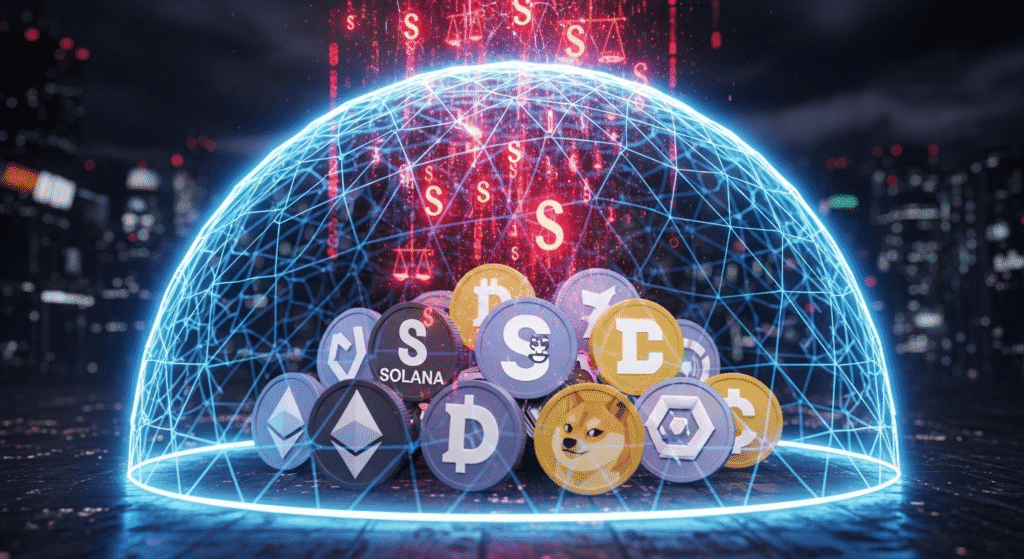Introduction
In a market that often feels like a digital rollercoaster, have you ever stopped to consider the potential storm clouds gathering on the horizon for your carefully curated altcoin portfolio? With the ever-evolving landscape of **Crypto Regulation, understanding how to protect your digital assets isn’t just wise; it’s paramount. For many, the allure of altcoins, the meme coin madness, or the unexpected bounty of airdrops represents a significant portion of their crypto journey. But as governments worldwide tighten their grip and clarify their stances, safeguarding these often more volatile assets becomes a critical undertaking. This guide dives deep into actionable strategies to shield your altcoins, ensuring you navigate the complex world of **Altcoin Regulation with confidence and security.
Crypto Market Overview
The cryptocurrency market, a dynamic arena characterized by rapid innovation and price fluctuations, is currently experiencing a fascinating period for altcoins. While Bitcoin and Ethereum continue to dominate headlines, the altcoin sector is showcasing remarkable resilience and growth potential. We’re seeing a surge in interest not only in established altcoins with strong use cases but also in newer, more experimental projects, including a vibrant meme coin ecosystem and innovative airdrop campaigns that continue to capture investor attention.
Key market indicators point towards a growing maturity in this segment of the crypto economy. Trading volumes for many altcoins are on the rise, signaling increased investor confidence and participation. Decentralized Finance (DeFi) protocols, often built on alternative blockchains, are expanding their reach, offering new avenues for yield generation and investment. Furthermore, the increasing mainstream adoption of blockchain technology is indirectly fueling the demand for diverse digital assets, many of which fall under the altcoin umbrella.
However, this growth is not without its complexities. The regulatory environment remains a significant factor influencing market sentiment and investment flows. As regulatory bodies worldwide begin to implement clearer frameworks, the landscape for altcoins is set to transform. Understanding these shifts is crucial for any serious crypto investor looking to protect and grow their holdings.

The Core Concept: How Altcoins and Meme Coins Actually Work
The world of cryptocurrencies extends far beyond Bitcoin. Altcoins, a portmanteau of “alternative coins,” represent all cryptocurrencies other than Bitcoin. They were born from a desire to improve upon Bitcoin’s perceived limitations or to explore entirely new blockchain functionalities and use cases.
What Are Altcoins, Meme Coins, and Airdrops?
Altcoins are digital or virtual currencies that use cryptography for security and operate on a blockchain, just like Bitcoin. However, they differentiate themselves through various means, such as offering faster transaction times, different consensus mechanisms (like Proof-of-Stake instead of Bitcoin’s Proof-of-Work), enhanced privacy features, or specialized applications in areas like decentralized finance (DeFi), smart contracts, or supply chain management.
Meme coins, a more recent and often speculative phenomenon, are cryptocurrencies that gain popularity primarily through social media trends and internet memes. While some, like Dogecoin and Shiba Inu, have garnered significant market capitalization and community support, their value is often more driven by hype and community sentiment than by underlying technological innovation or utility. This emotional and viral aspect makes them particularly susceptible to extreme price swings.
Airdrops, on the other hand, are a marketing strategy where new cryptocurrencies distribute free tokens to a wide audience, usually to wallet holders of a specific cryptocurrency or to users who complete certain tasks (like signing up for a newsletter or following a social media account). The goal is to raise awareness about a new project, build a community, and encourage wider adoption of their token or platform. While often a welcome bonus for crypto holders, the legitimacy and long-term value of airdropped tokens can vary significantly.
Key Components & Technologies
The underlying technology powering most altcoins, including meme coins and the tokens distributed via airdrops, is blockchain technology. This distributed ledger system ensures transparency, security, and immutability of transactions.
Many altcoins are built on their own unique blockchains, while others are created as tokens on existing blockchain platforms like Ethereum (ERC-20 standard), Binance Smart Chain (BEP-20 standard), or Solana. These platforms provide the infrastructure for creating and managing smart contracts, which are self-executing contracts with the terms of the agreement directly written into code.
Decentralized Finance (DeFi) is a rapidly growing sector that heavily relies on altcoins. DeFi platforms aim to recreate traditional financial services—such as lending, borrowing, trading, and insurance—on decentralized blockchain networks, without intermediaries. Many altcoins serve as the native tokens for these DeFi protocols, granting users utility, governance rights, or rewards within the ecosystem.
The tokenomics – the economic model of a cryptocurrency – also plays a crucial role. This includes factors like the total supply of tokens, the distribution model, inflation/deflationary mechanisms, and the utility of the token within its ecosystem, all of which significantly impact its perceived value and long-term sustainability.
The Data-Driven Perspective
To truly understand the current climate for altcoins and meme coins, we must turn to the data. The market performance of these digital assets reveals a fascinating, albeit often volatile, narrative.
Market Data & Trends
Recent analyses indicate a significant resurgence in the altcoin market, with many projects experiencing substantial growth in market capitalization. While Bitcoin often sets the trend, the past year has seen several altcoins outperform BTC, particularly those with strong technological underpinnings or innovative use cases in DeFi, NFTs (Non-Fungible Tokens), and Web3 infrastructure.
For instance, data from CoinMarketCap or CoinGecko regularly highlights that the total market capitalization of altcoins (excluding Bitcoin) can represent a substantial portion of the overall crypto market, sometimes exceeding 60%. Specific sectors within altcoins, such as layer-1 blockchains (e.g., Solana, Cardano) or decentralized storage solutions, have seen increased developer activity and investor inflow.
Meme coins, while historically more speculative, have also demonstrated periods of explosive growth, often fueled by social media virality and influencer endorsements. However, their performance is notoriously unpredictable. For example, a meme coin might see a 500% surge in a matter of days, only to experience a 70% pullback shortly after, highlighting their extreme volatility.
Airdrop campaigns, while not directly reflected in market cap data in the same way, contribute to token circulation and community building. The number of active airdrop protocols and participating wallets can be tracked through blockchain explorers and crypto analytics platforms, offering insights into the engagement levels for new projects.
Tokenomics & Market Health
The health of an altcoin or meme coin ecosystem is heavily dependent on its tokenomics. A well-designed tokenomic model aims to create sustainable demand, reward participation, and ensure the long-term viability of the project.
Supply: The total supply of tokens, and whether it’s fixed or inflationary, significantly impacts value. For example, cryptocurrencies with a fixed or deflationary supply (where tokens are burned or removed from circulation) can, in theory, become scarcer over time, potentially increasing their value if demand rises. Conversely, highly inflationary tokens can dilute value.
Demand Drivers: What makes people want to hold or use the token? Is it for governance, staking rewards, transaction fees within a specific network, or participation in DeFi protocols? Tokens with clear utility and strong demand drivers tend to be more robust.
Distribution: How were the tokens initially distributed? Was it a fair launch, a large percentage allocated to founders/investors (with vesting schedules), or a significant portion reserved for community airdrops? Concentrated ownership can lead to manipulation risks.
Vesting Schedules: For tokens allocated to early investors or team members, vesting schedules are critical. These schedules release tokens gradually over time, preventing a large sell-off that could crash the price. Transparent and fair vesting is a sign of a project’s commitment to long-term growth.
Analyzing these tokenomic factors provides a data-driven approach to assessing the fundamental health of an altcoin or meme coin, moving beyond speculative hype.
Risks, Challenges & Competition
While the potential rewards in the altcoin market can be significant, it’s crucial to acknowledge the inherent risks and competitive landscape.
Risks of Altcoins and Meme Coins
- Volatility: Altcoins, and particularly meme coins, are known for their extreme price volatility. Their value can fluctuate dramatically in short periods, leading to substantial losses for investors who are not prepared for these swings.
- Security Vulnerabilities: Newer altcoins or those on less established blockchains might be more susceptible to bugs, hacks, or smart contract exploits. These vulnerabilities can lead to the loss of funds for holders.
- Regulatory Uncertainty: The evolving **Crypto Regulation framework poses a significant risk. Governments may impose regulations that impact the trading, holding, or even the existence of certain altcoins, leading to market disruptions and potential value depreciation. Some altcoins might even be classified as unregistered securities, leading to delistings or legal challenges.
- Liquidity Issues: Smaller altcoins or less popular meme coins may suffer from low liquidity. This means it can be difficult to buy or sell them without significantly impacting the price, and you might not be able to exit your position at your desired price.
- Scams and Rug Pulls: The altcoin space, especially with the popularity of meme coins, is unfortunately rife with scams. “Rug pulls” are common, where developers abandon a project after attracting investment, taking the funds with them. Thorough due diligence is essential.
- Adoption and Utility: Many altcoins lack real-world utility or a strong use case beyond speculative trading. Their long-term value is often questionable if they don’t solve a real problem or offer a compelling service.
How Does [TOPIC] Stack Up Against Competitors?
When considering specific altcoins, it’s vital to analyze their competitive positioning within their respective niches. For the purpose of this section, let’s consider a hypothetical next-generation smart contract platform altcoin, “QuantumChain (QTC),” and benchmark it against established players.
| Feature | QuantumChain (QTC) | Ethereum (ETH) | Solana (SOL) |
|---|---|---|---|
| Consensus Mechanism | Proof-of-Stake (PoS) with Sharding | Proof-of-Stake (PoS) | Proof-of-History (PoH) + PoS |
| Transaction Speed | 10,000+ TPS (Target) | ~15-30 TPS (Post-Merge) | ~65,000+ TPS (Theoretical Peak) |
| Transaction Fees | Very Low (Micropayments) | Moderate to High (Variable, can spike) | Very Low |
| Developer Ecosystem | Growing, strong focus on scalability | Mature and extensive, vast dApp library | Robust, known for speed and low costs |
| Smart Contract Lang. | Custom (Q-Script), Rust | Solidity | Rust, C |
| Interoperability | Advanced cross-chain bridges | Developing (e.g., Polkadot, Cosmos integrations) | Growing ecosystem of cross-chain solutions |
| Tokenomics | Fixed supply, staking rewards, deflationary burns | Inflationary (with burn mechanism) | Inflationary, staking rewards |
| Security Focus | Enhanced privacy features, formal verification | High, battle-tested | High, but has faced network stability issues |
| Unique Selling Prop. | Unparalleled scalability and secure privacy | Largest dApp ecosystem, established network | Extreme speed, low fees, vibrant NFT market |
This comparative table helps illustrate that while QTC aims for superior scalability and privacy, it faces stiff competition from the established network effects and developer base of Ethereum and the sheer speed of Solana. Investors would need to weigh these factors, alongside the evolving regulatory environment, when making investment decisions.
The Future Outlook
The trajectory of altcoins, meme coins, and airdrops in the coming years will be shaped by a confluence of technological advancements, market sentiment, and, crucially, the evolving global regulatory landscape.
What’s Next for Altcoins, Meme Coins, and Airdrops?
For Altcoins: We anticipate a continued focus on utility and real-world adoption. Projects that solve genuine problems, enhance efficiency, or offer compelling decentralized services are more likely to gain sustainable traction. Scalability solutions, interoperability between different blockchains, and enhanced security will remain key areas of development. The growing integration of blockchain technology into various industries – from finance and supply chain to gaming and metaverse – will create new use cases for many altcoins.
However, **Crypto Regulation will undoubtedly play a pivotal role. Clearer regulations could foster mainstream adoption by providing a more predictable environment for institutions and retail investors alike. Conversely, overly restrictive regulations could stifle innovation and push development to more crypto-friendly jurisdictions. We may see a consolidation in the market, with less viable projects fading away, while those with strong fundamentals and clear roadmaps thrive.
For Meme Coins: The future of meme coins remains highly speculative. Their longevity is intrinsically tied to their community engagement and viral marketing. While some may evolve to incorporate utility beyond their initial meme status, many will likely remain highly volatile and prone to speculative bubbles. They will continue to serve as a barometer for retail investor sentiment and a testing ground for new forms of decentralized community building.
For Airdrops: Airdrops are likely to persist as a popular marketing tool for new projects. However, as the space matures, we might see a more discerning approach from users, who will increasingly scrutinize the legitimacy and potential value of airdropped tokens. Projects may also implement more sophisticated airdrop strategies, rewarding active community members or users who engage meaningfully with their platforms rather than simply collecting tokens indiscriminately. Regulatory scrutiny may also extend to airdrops, particularly if they are viewed as promotional tools for unregistered securities.
The coming years will likely see greater demand for altcoins that demonstrate robust technology, clear use cases, strong community backing, and compliance with the ongoing developments in Altcoin Regulation.
Conclusion
Navigating the dynamic cryptocurrency market, particularly the intricate world of altcoins and meme coins, demands a proactive approach to security and protection. We’ve explored the diverse landscape of alternative digital assets, their underlying technologies, and the critical importance of understanding their tokenomics. The inherent volatility and the ever-present shadow of regulatory developments underscore the need for informed strategies.
In summary, safeguarding your altcoins hinges on a multi-faceted approach: thorough research into the project’s fundamentals, understanding tokenomics, and staying ahead of evolving **Crypto Regulation. By diversifying wisely, utilizing secure wallets, and being genuinely skeptical of overly hyped projects, you can significantly mitigate risks.
What are your top strategies for protecting your altcoins in this rapidly changing environment? Which altcoins are you most excited about for the future, and why? Share your thoughts and insights in the comments below!
For those seeking to deepen their knowledge, be sure to explore our other articles on decentralized finance strategies and navigating meme coin markets. And don’t forget to subscribe to our newsletter for the latest updates and expert analysis delivered straight to your inbox!
FAQs
1. What is the biggest risk associated with altcoins?
The biggest risk is often considered to be extreme volatility. Altcoin prices can plummet dramatically in a short period, leading to significant financial losses. Regulatory uncertainty is also a major risk, as new regulations can impact the legality and trading of certain altcoins.
2. How can I protect my altcoins from scams?
Protecting your altcoins from scams involves diligent research (DYOR – Do Your Own Research). Look for active development, a transparent team, a clear use case, and a healthy community. Be wary of projects that promise guaranteed high returns, have vague whitepapers, or pressure you to invest quickly. Always use reputable exchanges and secure hardware wallets for significant holdings.
3. Will stricter crypto regulation affect my altcoins?
Crypto Regulation is designed to bring clarity and safety to the market, but its implementation can indeed affect altcoins. Some altcoins might be classified as securities and face delisting or new compliance requirements. Others may benefit from clearer rules, attracting more institutional investment. It’s crucial to stay informed about regulatory developments in your jurisdiction and for the specific altcoins you hold.
4. Are meme coins a good investment?
Meme coins are highly speculative investments. Their value is often driven by social media trends and community sentiment rather than intrinsic utility. While some investors have made significant profits, many have also incurred substantial losses. They are generally considered high-risk, and it’s advisable to invest only what you can afford to lose.
5. What are the best practices for securing my crypto assets?
Best practices include using strong, unique passwords for all exchanges and wallets, enabling two-factor authentication (2FA), and considering hardware wallets (like Ledger or Trezor) for long-term storage. Be cautious about phishing attempts and never share your private keys or seed phrases with anyone.
6. How do airdrops work, and are they safe?
Airdrops are a way for new crypto projects to distribute tokens to early adopters or the wider community, often as a marketing strategy. While many airdrops are legitimate, some can be used for scams. Be cautious of airdrops that ask for your private keys or require you to send crypto first. Only participate in airdrops from reputable projects and ensure you’re interacting with official websites and social media channels.
7. What’s the difference between an altcoin and a token?
Generally, an altcoin refers to any cryptocurrency other than Bitcoin. This can include coins that have their own independent blockchain (like Ethereum, Solana) or tokens that are built on existing blockchains (like many DeFi tokens on Ethereum, which are ERC-20 tokens). The term “altcoin” is often used inclusively for both independent cryptocurrencies and tokens that are not Bitcoin.






